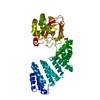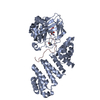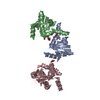[English] 日本語
 Yorodumi
Yorodumi- PDB-5jz6: Aspartyl/Asparaginyl beta-hydroxylase (AspH)oxygenase and TPR dom... -
+ Open data
Open data
- Basic information
Basic information
| Entry | Database: PDB / ID: 5jz6 | ||||||
|---|---|---|---|---|---|---|---|
| Title | Aspartyl/Asparaginyl beta-hydroxylase (AspH)oxygenase and TPR domains in complex with manganese and L-malate | ||||||
 Components Components | Aspartyl/asparaginyl beta-hydroxylase | ||||||
 Keywords Keywords | OXIDOREDUCTASE / 2-oxoglutarate dependent oxygenase / aspartyl/asparaginyl beta-hydroxylase / EGF-like domain hydroxylase / double stranded beta-helix / tetratricopeptide repeat | ||||||
| Function / homology |  Function and homology information Function and homology informationpeptide-aspartate beta-dioxygenase / : / regulation of protein depolymerization / activation of store-operated calcium channel activity / regulation of cell communication by electrical coupling / junctional sarcoplasmic reticulum membrane / peptidyl-aspartic acid 3-dioxygenase activity / sarcoplasmic reticulum lumen / limb morphogenesis / positive regulation of intracellular protein transport ...peptide-aspartate beta-dioxygenase / : / regulation of protein depolymerization / activation of store-operated calcium channel activity / regulation of cell communication by electrical coupling / junctional sarcoplasmic reticulum membrane / peptidyl-aspartic acid 3-dioxygenase activity / sarcoplasmic reticulum lumen / limb morphogenesis / positive regulation of intracellular protein transport / cortical endoplasmic reticulum / pattern specification process / face morphogenesis / structural constituent of muscle / response to ATP / roof of mouth development / Protein hydroxylation / positive regulation of calcium ion transport into cytosol / positive regulation of proteolysis / detection of calcium ion / regulation of cytosolic calcium ion concentration / regulation of cardiac muscle contraction by regulation of the release of sequestered calcium ion / calcium ion homeostasis / regulation of release of sequestered calcium ion into cytosol by sarcoplasmic reticulum / Ion homeostasis / calcium channel complex / sarcoplasmic reticulum membrane / cellular response to calcium ion / muscle contraction / calcium ion transmembrane transport / regulation of protein stability / Stimuli-sensing channels / transmembrane transporter binding / electron transfer activity / cell population proliferation / negative regulation of cell population proliferation / calcium ion binding / endoplasmic reticulum membrane / positive regulation of DNA-templated transcription / structural molecule activity / endoplasmic reticulum / plasma membrane Similarity search - Function | ||||||
| Biological species |  Homo sapiens (human) Homo sapiens (human) | ||||||
| Method |  X-RAY DIFFRACTION / X-RAY DIFFRACTION /  SYNCHROTRON / SYNCHROTRON /  MOLECULAR REPLACEMENT / Resolution: 2.354 Å MOLECULAR REPLACEMENT / Resolution: 2.354 Å | ||||||
 Authors Authors | McDonough, M.A. / Pfeffer, I. | ||||||
 Citation Citation |  Journal: Nat Commun / Year: 2019 Journal: Nat Commun / Year: 2019Title: Aspartate/asparagine-beta-hydroxylase crystal structures reveal an unexpected epidermal growth factor-like domain substrate disulfide pattern. Authors: Pfeffer, I. / Brewitz, L. / Krojer, T. / Jensen, S.A. / Kochan, G.T. / Kershaw, N.J. / Hewitson, K.S. / McNeill, L.A. / Kramer, H. / Munzel, M. / Hopkinson, R.J. / Oppermann, U. / Handford, ...Authors: Pfeffer, I. / Brewitz, L. / Krojer, T. / Jensen, S.A. / Kochan, G.T. / Kershaw, N.J. / Hewitson, K.S. / McNeill, L.A. / Kramer, H. / Munzel, M. / Hopkinson, R.J. / Oppermann, U. / Handford, P.A. / McDonough, M.A. / Schofield, C.J. | ||||||
| History |
|
- Structure visualization
Structure visualization
| Structure viewer | Molecule:  Molmil Molmil Jmol/JSmol Jmol/JSmol |
|---|
- Downloads & links
Downloads & links
- Download
Download
| PDBx/mmCIF format |  5jz6.cif.gz 5jz6.cif.gz | 194.8 KB | Display |  PDBx/mmCIF format PDBx/mmCIF format |
|---|---|---|---|---|
| PDB format |  pdb5jz6.ent.gz pdb5jz6.ent.gz | 153.4 KB | Display |  PDB format PDB format |
| PDBx/mmJSON format |  5jz6.json.gz 5jz6.json.gz | Tree view |  PDBx/mmJSON format PDBx/mmJSON format | |
| Others |  Other downloads Other downloads |
-Validation report
| Summary document |  5jz6_validation.pdf.gz 5jz6_validation.pdf.gz | 457.2 KB | Display |  wwPDB validaton report wwPDB validaton report |
|---|---|---|---|---|
| Full document |  5jz6_full_validation.pdf.gz 5jz6_full_validation.pdf.gz | 460.3 KB | Display | |
| Data in XML |  5jz6_validation.xml.gz 5jz6_validation.xml.gz | 21.4 KB | Display | |
| Data in CIF |  5jz6_validation.cif.gz 5jz6_validation.cif.gz | 29.1 KB | Display | |
| Arichive directory |  https://data.pdbj.org/pub/pdb/validation_reports/jz/5jz6 https://data.pdbj.org/pub/pdb/validation_reports/jz/5jz6 ftp://data.pdbj.org/pub/pdb/validation_reports/jz/5jz6 ftp://data.pdbj.org/pub/pdb/validation_reports/jz/5jz6 | HTTPS FTP |
-Related structure data
| Related structure data |  5apaC  5jqyC  5jz8C  5jzaC  5jzuC  6rk9C C: citing same article ( |
|---|---|
| Similar structure data |
- Links
Links
- Assembly
Assembly
| Deposited unit | 
| ||||||||
|---|---|---|---|---|---|---|---|---|---|
| 1 |
| ||||||||
| Unit cell |
|
- Components
Components
| #1: Protein | Mass: 49405.336 Da / Num. of mol.: 1 Source method: isolated from a genetically manipulated source Source: (gene. exp.)  Homo sapiens (human) / Gene: ASPH, BAH / Production host: Homo sapiens (human) / Gene: ASPH, BAH / Production host:  References: UniProt: Q12797, peptide-aspartate beta-dioxygenase | ||||||
|---|---|---|---|---|---|---|---|
| #2: Chemical | ChemComp-MN / | ||||||
| #3: Chemical | ChemComp-GOL / #4: Chemical | ChemComp-LMR / ( | #5: Water | ChemComp-HOH / | Has protein modification | Y | |
-Experimental details
-Experiment
| Experiment | Method:  X-RAY DIFFRACTION / Number of used crystals: 1 X-RAY DIFFRACTION / Number of used crystals: 1 |
|---|
- Sample preparation
Sample preparation
| Crystal | Density Matthews: 3.02 Å3/Da / Density % sol: 59.32 % |
|---|---|
| Crystal grow | Temperature: 277 K / Method: vapor diffusion, sitting drop / pH: 7 Details: 1mM MMT buffer (DL-Malic acid, MES, Tris base), 25% PEG1500, 1 mM MnCl2, 2 mM N-oxalylglycine, 18 mg/ml protein |
-Data collection
| Diffraction | Mean temperature: 100 K |
|---|---|
| Diffraction source | Source:  SYNCHROTRON / Site: SYNCHROTRON / Site:  Diamond Diamond  / Beamline: I04 / Wavelength: 0.92 Å / Beamline: I04 / Wavelength: 0.92 Å |
| Detector | Type: DECTRIS PILATUS 6M-F / Detector: PIXEL / Date: Jun 10, 2014 |
| Radiation | Protocol: SINGLE WAVELENGTH / Monochromatic (M) / Laue (L): M / Scattering type: x-ray |
| Radiation wavelength | Wavelength: 0.92 Å / Relative weight: 1 |
| Reflection | Resolution: 2.35→47.16 Å / Num. obs: 25633 / % possible obs: 99.8 % / Redundancy: 6.5 % / Biso Wilson estimate: 35.39 Å2 / Rmerge(I) obs: 0.135 / Net I/σ(I): 14.2 |
| Reflection shell | Resolution: 2.35→2.43 Å / Redundancy: 5.9 % / Rmerge(I) obs: 0.896 / Mean I/σ(I) obs: 2.5 / % possible all: 99.9 |
- Processing
Processing
| Software |
| |||||||||||||||||||||||||||||||||||||||||||||||||||||||||||||||||||||||||||||||||||||||||||||||||||||||||||||||||||||||||||||
|---|---|---|---|---|---|---|---|---|---|---|---|---|---|---|---|---|---|---|---|---|---|---|---|---|---|---|---|---|---|---|---|---|---|---|---|---|---|---|---|---|---|---|---|---|---|---|---|---|---|---|---|---|---|---|---|---|---|---|---|---|---|---|---|---|---|---|---|---|---|---|---|---|---|---|---|---|---|---|---|---|---|---|---|---|---|---|---|---|---|---|---|---|---|---|---|---|---|---|---|---|---|---|---|---|---|---|---|---|---|---|---|---|---|---|---|---|---|---|---|---|---|---|---|---|---|---|
| Refinement | Method to determine structure:  MOLECULAR REPLACEMENT / Resolution: 2.354→47.153 Å / SU ML: 0.25 / Cross valid method: FREE R-VALUE / σ(F): 1.34 / Phase error: 20.53 MOLECULAR REPLACEMENT / Resolution: 2.354→47.153 Å / SU ML: 0.25 / Cross valid method: FREE R-VALUE / σ(F): 1.34 / Phase error: 20.53
| |||||||||||||||||||||||||||||||||||||||||||||||||||||||||||||||||||||||||||||||||||||||||||||||||||||||||||||||||||||||||||||
| Solvent computation | Shrinkage radii: 0.9 Å / VDW probe radii: 1.11 Å | |||||||||||||||||||||||||||||||||||||||||||||||||||||||||||||||||||||||||||||||||||||||||||||||||||||||||||||||||||||||||||||
| Displacement parameters | Biso max: 165.42 Å2 / Biso mean: 51.3736 Å2 / Biso min: 22.33 Å2 | |||||||||||||||||||||||||||||||||||||||||||||||||||||||||||||||||||||||||||||||||||||||||||||||||||||||||||||||||||||||||||||
| Refinement step | Cycle: final / Resolution: 2.354→47.153 Å
| |||||||||||||||||||||||||||||||||||||||||||||||||||||||||||||||||||||||||||||||||||||||||||||||||||||||||||||||||||||||||||||
| Refine LS restraints |
| |||||||||||||||||||||||||||||||||||||||||||||||||||||||||||||||||||||||||||||||||||||||||||||||||||||||||||||||||||||||||||||
| LS refinement shell | Refine-ID: X-RAY DIFFRACTION / Total num. of bins used: 14
| |||||||||||||||||||||||||||||||||||||||||||||||||||||||||||||||||||||||||||||||||||||||||||||||||||||||||||||||||||||||||||||
| Refinement TLS params. | Method: refined / Refine-ID: X-RAY DIFFRACTION
| |||||||||||||||||||||||||||||||||||||||||||||||||||||||||||||||||||||||||||||||||||||||||||||||||||||||||||||||||||||||||||||
| Refinement TLS group |
|
 Movie
Movie Controller
Controller












 PDBj
PDBj













